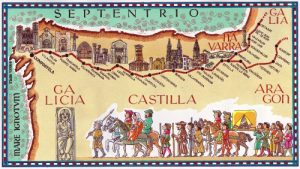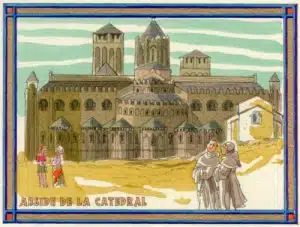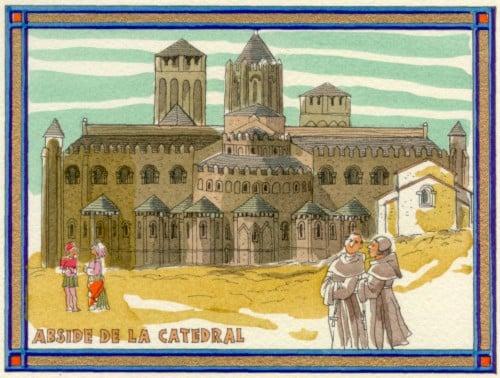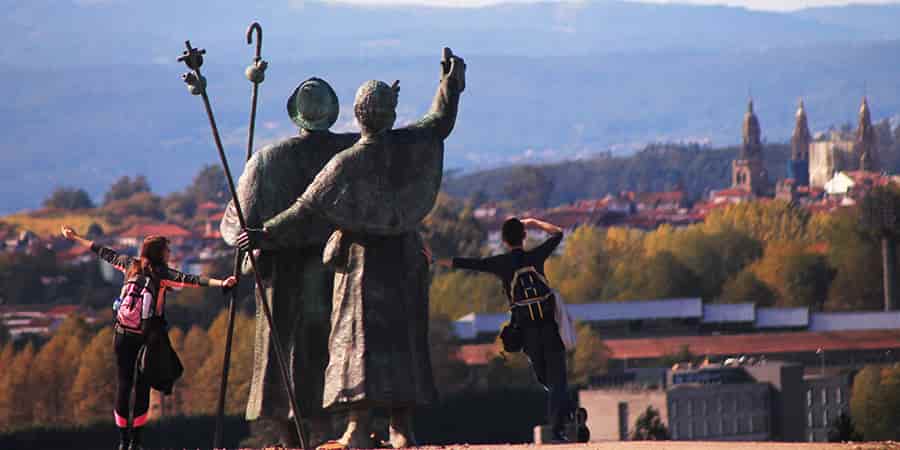Scholars once attributed the 12th-century illuminated manuscript, the Codex Calixtinus, to Pope Callixtus II. They now believe Aymeric Picaud, a French scholar, arranged it. The manuscript names its main author as “Scriptor I.” Its creators designed it to guide pilgrims along the Way of St James to the shrine of Saint James the Great. This shrine stands in the Cathedral of Santiago de Compostela, Galicia. People also know the Codex Calixtinus as the Liber Sancti Jacobi, or Book of Saint James.
Table of contents
It contains sermons, miracle stories, and liturgical texts linked to Saint James. There is also a remarkable collection of polyphonic music. The manuscript describes pilgrimage routes, art to see, and local customs. Thieves stole it on 5 July 2011, and police recovered it a year later.
History of the Codex Calixtinus
The origins and authorship have been debated for years. Scholars believe several authors contributed to it. It was likely compiled between 1135 and 1139 by Aymeric Picaud. The introduction includes a forged letter claiming to be from Pope Callixtus II, who died in 1124.
The earliest known copy is kept in the archives of Santiago Cathedral and dates to around 1150. The manuscript was lost for centuries until rediscovered in 1886 by Padre Fidel Fita. In 1173, the monk Arnaldo de Monte copied it. This version, called The Ripoll, is now in Barcelona.
The Church of Rome, especially the Abbey of Cluny, valued it highly. Copies spread from Rome to Jerusalem. Walter Muir Whitehill completed the first full transcription in 1932 and published it in Madrid in 1944.

Composition of the Codex Calixtinus
The Santiago copy has five books and 225 double-sided folios. Each page measures 295 by 214 mm. Most pages have one column of thirty-four lines. Book IV was removed in 1609 but restored in 1966.
The opening letter, supposedly from Pope Callixtus II, fills the first two folios. The author claims to have gathered testimonies about Saint James over fourteen years. He says the manuscript survived fires and near-drowning. It is addressed to the basilica of Cluny and Archbishop Diego of Compostela.

Book I – Book of the Liturgies
Book I, called Anthologia liturgica, is almost half the manuscript. It contains sermons, homilies, two accounts of Saint James’s martyrdom, and official liturgies for his veneration. Its focus on the spiritual meaning of pilgrimage makes it the heart of the codex.
Book II – Book of the Miracles
Book II, De miraculis sancti Jacobi, tells of twenty-two miracles attributed to Saint James. These miracles happened across Europe during his life and after his death. Many involve pilgrims as witnesses or recipients.
Book III – Translation of the Saint’s Body
Book III, Liber de translatione corporis sancti Jacobi ad Compostellam, is the shortest section. It describes the transfer of Saint James’s body from Jerusalem to Galicia. The text also mentions pilgrims collecting scallop shells on the Galician coast. This shell became a symbol of Saint James.

Book IV – The History of Charlemagne and Roland
Book IV is credited to Archbishop Turpín of Reims but was written by an unknown 12th-century author. It recounts Charlemagne’s campaign in Spain, his defeat at Roncevaux Pass, and the death of Roland. Saint James appears in a dream to Charlemagne, guiding him by the Milky Way to free his tomb from the Moors. This story inspired the Spanish name for the Milky Way, Camino de Santiago.
The book also describes Roland’s battle with the giant Saracen Ferragut. It promoted the legend of Saint James as Matamoros or “the Moorslayer,” encouraging support for the military Order of Santiago. In later years, the portrayal of Saint James as a warrior became controversial. King Philip III ordered Book IV removed. Yet churches along the Camino Frances still display images of Santiago Matamoros. Today, the legend is valued for its cultural and historical importance.

Book V – A Guide for the Traveller
Book V, Iter pro peregrinis ad Compostellam, is full of practical advice for pilgrims. It lists places to visit, relics to venerate, and dangers to avoid, including poor food and dishonest traders. The book offers a rare glimpse into the life of a 12th-century pilgrim.
It describes Santiago de Compostela and its cathedral. Its popularity made it the most famous section. Many scholars see it as the first tourist guidebook. It also contains some of the earliest written Basque words. Modern pilgrims still visit many of the same locations, though with far better facilities. In 1993, UNESCO listed the Spanish section of the route as a World Heritage Site. The French section was added in 1998.
Music of the Codex Calixtinus
The manuscript was meant to be sung aloud. It is an important early example of polyphonic music. It contains the first known piece for three voices, Congaudeant catholici. The dissonance in this piece has led some to think it was not meant for simultaneous performance. The music remains popular, with modern recordings still available today.
*Source: www.codexcalixtinus.es
For more information about the Camino de Santiago routes and all of the tours available please contact our Travel Specialists.



